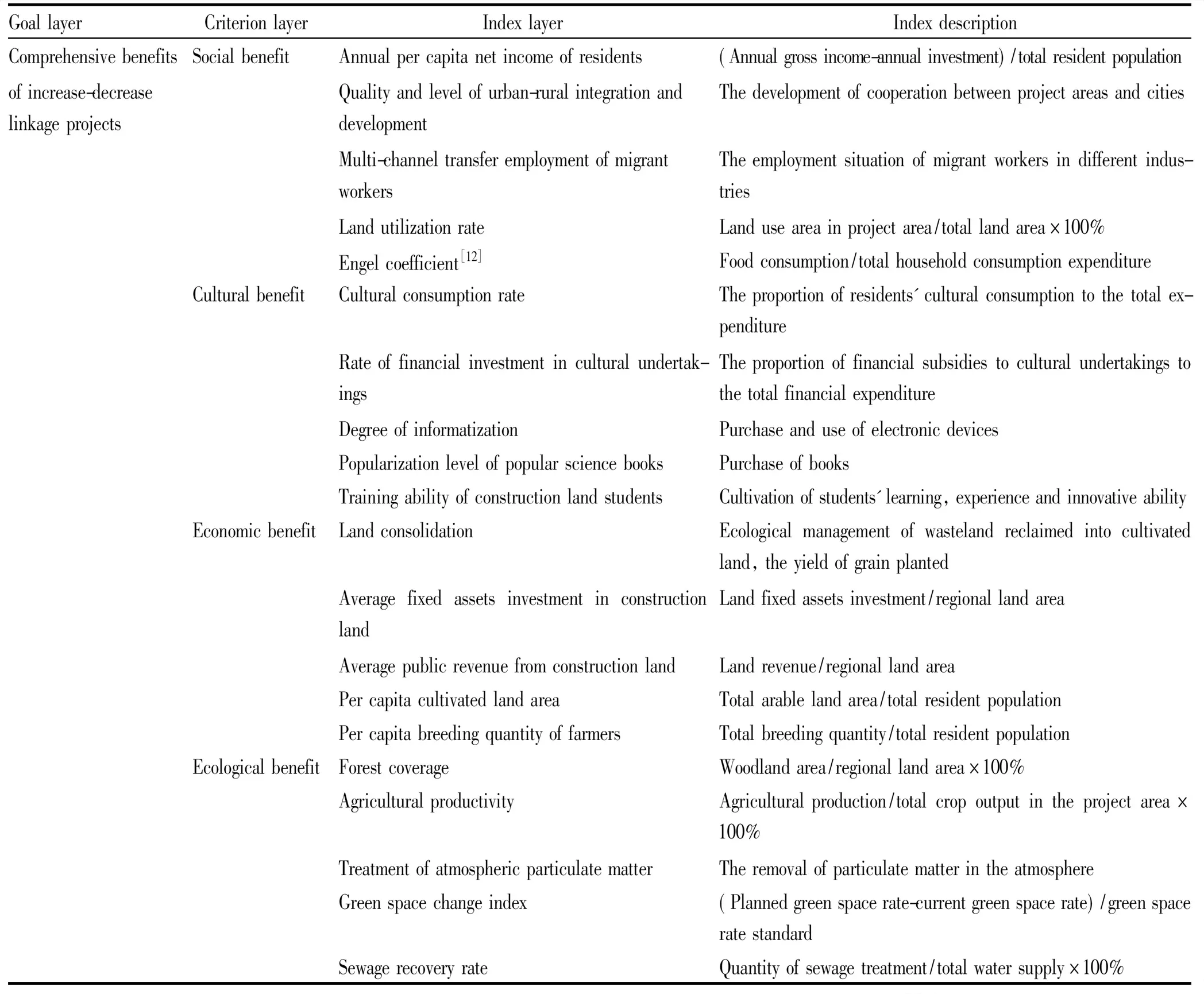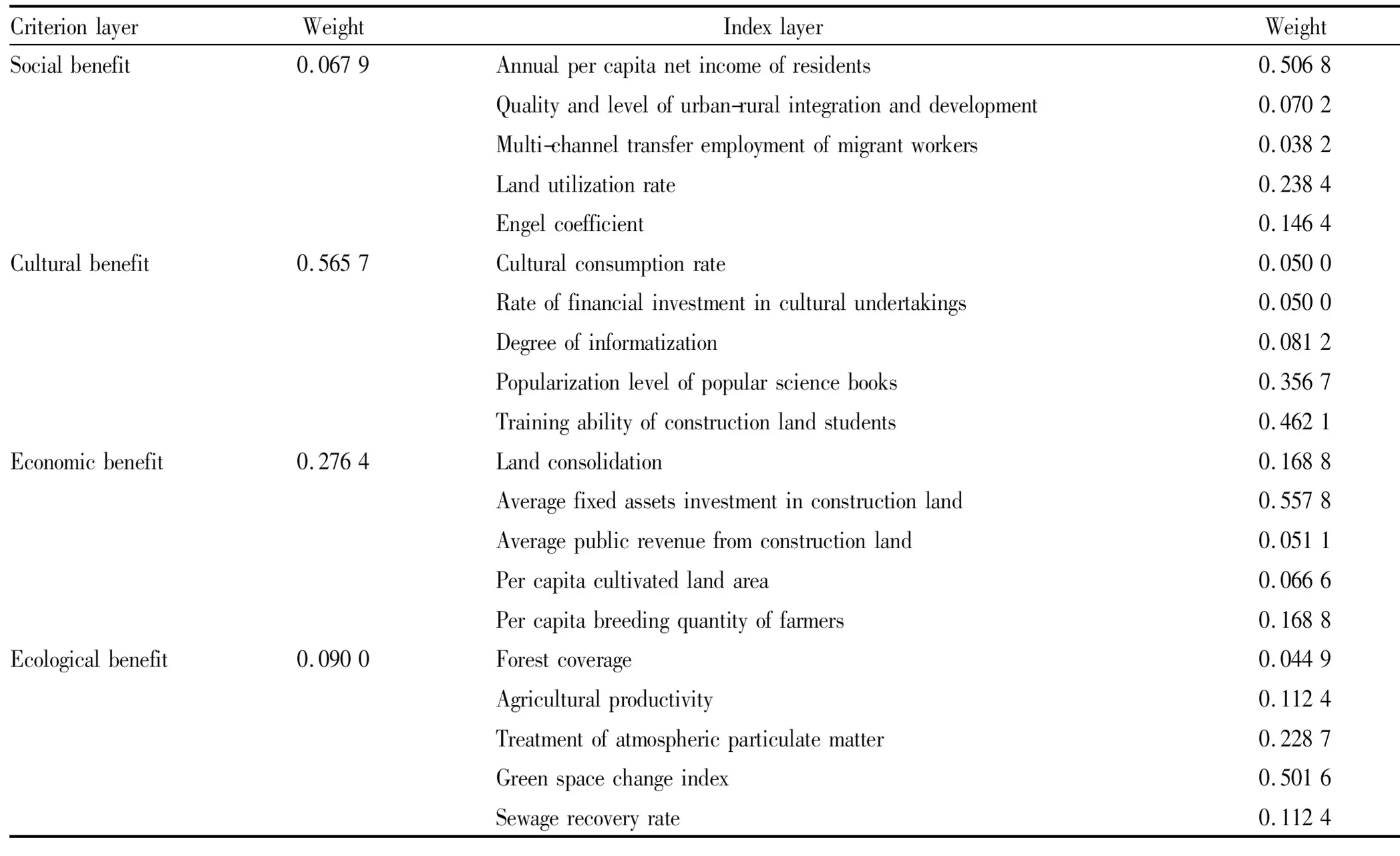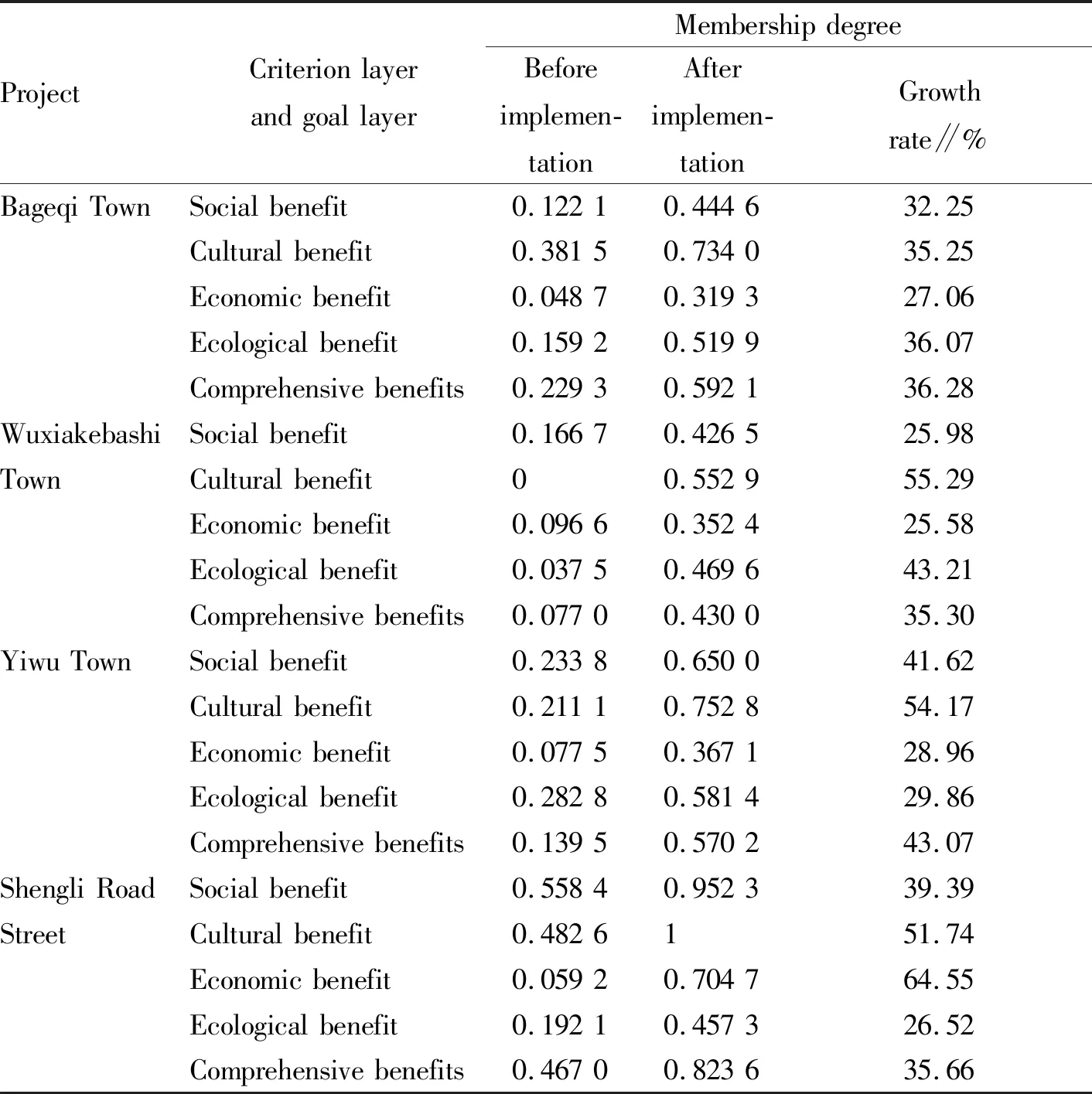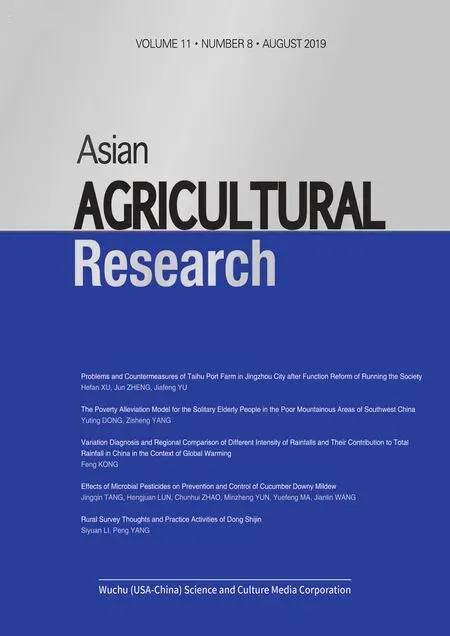Difference of Regional Benefits after Linking Newly-added Cropland Quotas with Amount of Land Used for Construction Based on Targeted Poverty Alleviation: A Case Study of Xinjiang
2019-09-19XionghuaYUANWeiliangTU
Xionghua YUAN, Weiliang TU
School of Economics, Yangtze University/Hubei Rural Development Research Center, Jingzhou 434025, China
Abstract In order to explore the differences of projects on linking newly-added cropland quotas with the amount of land used for construction in targeted poverty alleviation in different rural areas, this paper selects the social, economic, cultural and ecological evaluation indexes, and introduces the AHP method, to measure the benefits before and after the implementation of the four typical projects on linking newly-added cropland quotas with the amount of land used for construction in Xinjiang. The results show that after the implementation of the project, the social, economic, cultural, ecological and comprehensive benefits of each region have been improved, but the benefits of regions with different economic levels are significantly different. This paper holds that the projects on linking newly-added cropland quotas with the amount of land used for construction in different regions should be considered from the ultimate goal before the establishment and implementation of the project, so as to realize the win-win situation between the urban-rural requisition-compensation balance and the targeted poverty alleviation in rural areas.
Key words Increase-decrease linkage projects, Targeted poverty alleviation, Regional benefits
1 Introduction
With the rapid development of China’s economy and the acceleration of urbanization, the demand for urban and rural construction land is rising rapidly. As a way of land consolidation and reclamation, linking newly-added cropland quotas with the amount of land used for construction plays an important role in targeted poverty alleviation in rural areas, protecting cultivated land resources and alleviating the contradiction between supply and demand of urban construction land.
Since 2006, the project on linking newly-added cropland quotas with the amount of land used for construction has become a project to promote rural economic development and achieve targeted poverty alleviation in rural areas. In 2018, the No.1 document of the Central Committee restated the balance of occupation and compensation of cultivated land, and the need of giving priority to guaranteeing the land for development in the deeply impoverished areas by adding new quotas of construction land. Li Guoquanetal.[1]simply studied the benefit evaluation system and performance evaluation of projects on linking newly-added cropland quotas with the amount of land used for construction. Yu Mingxingetal.[2]used the comprehensive correction method to evaluate the layout of residential areas in mountainous areas where projects on linking newly-added cropland quotas with the amount of land used for construction were implemented, and analyzed the differences in the ability to link newly-added cropland quotas with the amount of land used for construction in different villages and towns. Ren Ping[3]believed that the linkage between increase and decrease had a positive performance in promoting the intensive use of rural land, alleviating the pressure of urban and rural construction land, coordinating urban and rural development and promoting new urbanization, improving the living environment and so on. Nie Yingetal.[4]considered that the comprehensive benefit of the project area was obviously improved after agricultural land development and consolidation. Shangguan Caixiaetal.[5]believed that the implementation of the policy of linking newly-added cropland quotas with the amount of land used for construction would lead to the reduction of farmers’ living area and the deterioration of the environment, but the rural land has been used intensively to a certain extent. Yao Shurongetal.[6]believed that the model of farmers linking newly-added cropland quotas with the amount of land used for construction not only solved the problem of ensuring the economy and protecting cultivated land, but also improved the welfare of farmers to a great extent. It can be seen that scholars are very rich in the research results on linking newly-added cropland quotas with the amount of land used for construction from different perspectives, but the research on the difference of "targeted poverty alleviation" is not enough, so it is necessary to reveal the win-win characteristics of "increase-decrease linkage" and "targeted poverty alleviation".
2 Research objects and methods
2.1 Research objectsThis paper selects four typical projects on linking newly-added cropland quotas with the amount of land used for construction in Xinjiang Uygur Autonomous Region as the research objects: the project of Bageqi Town, Hotan County, which is especially poor at the national level; the project of Wuxiakebashi Town, Yecheng County, which is poor at the national level; the project of Yiwu Town in Yiwu County, which is lifted out of poverty; the project of Shengli Road Street, Tianshan District, Urumqi City, which is relatively rich. They represent the regions of four economic levels (especially poor; poor; out of poverty; relatively rich) in turn, as outlined in Table 1.
Table 1 Overview of the economy of the study area in 2017

RegionsTotalpopulation104RegionaltotalGDP104yuanAgriculturalpopulation104PoorpopulationinagricultureProportionofpoorpopulationinagriculture∥%Agriculturalpercapitaincome∥yuanCultivatedlandarea∥haPovertylevelHotanCounty35.6934246913.4657125259.30744130562.68ExtremelypoorYechengCounty55.4282683516.4310836995.10801375683.83PoorYiwu2.125532880.481137277.74153877661.26Poverty-freeUrumqi222.62273064556.882044496.461783980289.00Rich
Data source:StatisticalYearbookofXinjiangUygurAutonomousRegion.
2.2 Selection of research methods and construction of models
2.2.1Methods. There are many fuzzy indexes in the projects on linking newly-added cropland quotas with the amount of land used for construction, and the benefits are fuzzy and complex in nature. Therefore, it is appropriate to use the theory of fuzzy mathematics to comprehensively evaluate many factors and indexes. The analytic hierarchy process (AHP) is introduced to determine the weight of the index, and the problem is decomposed into different components. According to the interrelated influence of the factors and the subordinate relationship, the factors are aggregated and combined according to different levels to form a multi-level analytical structure model. As a result, the problem comes down to the determination of the relative importance weights or the relative order of advantages and disadvantages at the lowest level (the schemes and measures for decision-making,etc.) relative to the highest level (the overall goal).
2.2.2Construction of fuzzy evaluation model. In this paper, the membership degree of benefit is measured by fuzzy comprehensive evaluation method, and the four typical projects on linking newly-added cropland quotas with the amount of land used for construction in Xinjiang Uygur Autonomous Region are evaluated. Let the comprehensive benefit of projects on linking newly-added cropland quotas with the amount of land used for construction beY, index setA={a1,a2, …,an}, evaluation grade setB={b1,b2, …,bn}. The fuzzy evaluation of each index in A is carried out according to the grade index of the evaluation set, and the judgment matrix is obtained:

2.3 Construction of evaluation index systemBased on the investigation of the basic situation of the study area, 20 indexes are selected from four aspects of social, economic, cultural and ecological benefits to construct the benefit evaluation index system of projects on linking newly-added cropland quotas with the amount of land used for construction (Table 2). Among them, the quality and level of urban-rural integration and development, the multi-channel transfer employment of migrant workers, the degree of informatization, the popularization level of construction land popular science books, the training ability of construction land students and the treatment of atmospheric particulate matter are not suitable for direct statistical measurement. In this paper, taking the satisfaction level of residents as the quantitative standard, the satisfaction level of descriptive indexes is set: very unsatisfactory, unsatisfactory, average, satisfactory, very satisfactory, assigned values 1, 3, 5, 7, 9, respectively. This paper also takes the average value of the evaluation of the satisfaction degree of the residents in the project area as the final quantitative value of the corresponding indexes.
3 Measurement of benefits of projects on linking newly-added cropland quotas with the amount of land used for construction
3.1 Determination of the weight of evaluation indexesThe relative importance of different primary indexes in various index layers, and social, cultural, economic and ecological benefits in comprehensive benefits is determined by the weight. Through the expert scoring method and Excel algorithm in AHP, as well as the statistics and research data of Xinjiang Uygur Autonomous Region, this paper obtains the final weight of each project evaluation index (Table 3).
3.2 Measurement of the benefits of projects on linking newly-added cropland quotas with the amount of land used for constructionThe statistical data are changed linearly. On the basis of the membership function of the primary index, the membership degree of the evaluation index in the project area is calculated according to the membership degree formula. Then, according to the weight and membership function value of each index in the goal layer and index layer, the membership degree of social, cultural, economic, ecological and comprehensive benefits after the implementation of projects on linking newly-added cropland quotas with the amount of land used for construction is summed up, and the measurement results of the four projects are shown in Table 4.
Table 2 The benefit evaluation index system of projects on linking newly-added cropland quotas with the amount of land used for construction

GoallayerCriterionlayerIndexlayerIndexdescriptionComprehensivebenefitsSocialbenefitAnnualpercapitanetincomeofresidents(Annualgrossincome-annualinvest-ment)/totalresidentpopulationofincrease-decreaselinkageprojectsQualityandlevelofurban-ruralintegrationanddevelopmentThedevelopmentofcooperationbe-tweenprojectareasandcitiesMulti-channeltransferemploymentofmigrantworkersTheemploymentsituationofmigrantworkersindifferentindustriesLandutilizationrateLanduseareainprojectarea/totallandarea×100%Engelcoefficient[12]Foodconsumption/totalhouseholdcon-sumptionexpenditureCulturalbenefitCulturalconsumptionrateTheproportionofresidentsculturalconsumptiontothetotalexpenditureRateoffinancialinvestmentinculturalundertak-ingsTheproportionoffinancialsubsidiestoculturalundertakingstothetotalfinan-cialexpenditureDegreeofinformatizationPurchaseanduseofelectronicdevicesPopularizationlevelofpopularsciencebooksPurchaseofbooksTrainingabilityofconstructionlandstudentsCultivationofstudentslearning,experi-enceandinnovativeabilityEconomicbenefitLandconsolidationEcologicalmanagementofwastelandre-claimedintocultivatedland,theyieldofgrainplantedAveragefixedassetsinvestmentinconstructionlandLandfixedassetsinvestment/regionallandareaAveragepublicrevenuefromconstructionlandLandrevenue/regionallandareaPercapitacultivatedlandareaTotalarablelandarea/totalresidentpopulationPercapitabreedingquantityoffarmersTotalbreedingquantity/totalresidentpopulationEcologicalbenefitForestcoverageWoodlandarea/regionallandarea×100%AgriculturalproductivityAgriculturalproduction/totalcropout-putintheprojectarea×100%TreatmentofatmosphericparticulatematterTheremovalofparticulatematterintheatmosphereGreenspacechangeindex(Plannedgreenspacerate-currentgreenspacerate)/greenspaceratestandardSewagerecoveryrateQuantityofsewagetreatment/totalwa-tersupply×100%
Table 3 Weights of evaluation indexes

CriterionlayerWeightIndexlayerWeightSocialbenefit0.0679Annualpercapitanetincomeofresidents0.5068Qualityandlevelofurban-ruralintegrationanddevelopment0.0702Multi-channeltransferemploymentofmigrantworkers0.0382Landutilizationrate0.2384Engelcoefficient0.1464Culturalbenefit0.5657Culturalconsumptionrate0.0500Rateoffinancialinvestmentinculturalundertakings0.0500Degreeofinformatization0.0812Popularizationlevelofpopularsciencebooks0.3567Trainingabilityofconstructionlandstudents0.4621Economicbenefit0.2764Landconsolidation0.1688Averagefixedassetsinvestmentinconstructionland0.5578Averagepublicrevenuefromconstructionland0.0511Percapitacultivatedlandarea0.0666Percapitabreedingquantityoffarmers0.1688Ecologicalbenefit0.0900Forestcoverage0.0449Agriculturalproductivity0.1124Treatmentofatmosphericparticulatematter0.2287Greenspacechangeindex0.5016Sewagerecoveryrate0.1124
Table 4 The benefit measurement results of projects on linking newly-added cropland quotas with the amount of land used for construction

ProjectCriterionlayerandgoallayerMembershipdegreeBeforeimplemen-tationAfterimplemen-tationGrowthrate∥%BageqiTownSocialbenefit0.12210.444632.25Culturalbenefit0.38150.734035.25Economicbenefit0.04870.319327.06Ecologicalbenefit0.15920.519936.07Comprehensivebenefits0.22930.592136.28WuxiakebashiSocialbenefit0.16670.426525.98TownCulturalbenefit00.552955.29Economicbenefit0.09660.352425.58Ecologicalbenefit0.03750.469643.21Comprehensivebenefits0.07700.430035.30YiwuTownSocialbenefit0.23380.650041.62Culturalbenefit0.21110.752854.17Economicbenefit0.07750.367128.96Ecologicalbenefit0.28280.581429.86Comprehensivebenefits0.13950.570243.07ShengliRoadSocialbenefit0.55840.952339.39StreetCulturalbenefit0.4826151.74Economicbenefit0.05920.704764.55Ecologicalbenefit0.19210.457326.52Comprehensivebenefits0.46700.823635.66
4 Analysis of benefit difference in the projects on linking newly-added cropland quotas with the amount of land used for construction
4.1 Analysis of the difference of economic benefits and comprehensive benefitsFrom Table 3 and Table 4, it is known that after the implementation of the project of Shengli Road Street, Tianshan District, Urumqi City, which is relatively rich, the growth rate of economic benefit is the highest, reaching 64.55%. The growth rate of economic benefits of especially poor, poor and poverty-free counties is about 25%, which is mainly due to the large number of talents, advanced technology and more financial investments in economically developed counties. However, there is no significant difference in the improvement rate of comprehensive benefits in regions of different economic levels, and the growth rate of comprehensive benefits in different regions is more than 35%, indicating that the comprehensive benefits before and after the implementation of the project have been significantly improved. However, the growth rate of comprehensive benefits in especially poor areas and poverty-free areas is slightly higher than that of relatively developed regions after the implementation of projects on linking newly-added cropland quotas with the amount of land used for construction. This shows that the growth rate of comprehensive benefits of two thirds of poor areas in the samples is slightly higher than that of relatively developed areas, which reasonably reflects the different effect of projects on linking newly-added cropland quotas with the amount of land used for construction on different regions.
4.2 Analysis of the differences in social, cultural and ecological benefitsThrough the comparison, it is found that the growth rate of social benefits after the implementation of projects on linking newly-added cropland quotas with the amount of land used for construction is in the order of poverty-free counties> especially poor counties> relatively rich counties> poor counties. The growth rate in especially poor areas and poor areas is 35.25% and 25.98%, respectively, and the highest growth rate is 41.62% in poverty-free counties, which is 2 percentage points higher than 39.39% in relatively rich areas. After the implementation of the project, the cultural benefits of each region have been significantly improved. Among them, the cultural benefits in poor counties and poverty-free counties increase the most significantly, with the growth rate of 55.29% and 54.17%, respectively. The growth rate of ecological benefit membership degree in poor counties after the implementation of the project is 43.21%, and the ecological benefits in other regions are better than before. However, the more developed the economy is, the lower the growth rate of ecological benefit is, indicating that the ecological benefit will be restricted by social and economic development and ecological basic conditions to a certain extent.
4.3 Structural difference analysis of targeted poverty alleviation benefits of projectsFrom Table 4, it can be seen that after the implementation of each project, there is no significant difference in the degree of membership of comprehensive benefits in different regions, except for the project of Yiwu Town, and it seems that there is no difference in the effectiveness of the implementation of the project. Through further calculation and analysis of the variance of membership degree before and after the implementation, the significance results of various factor indexes in different regions are obtained (Table 5). The cultural benefits of each regional project are significant, the economic benefits of Yiwu Town project and Shengli Road Street project are significant, but the ecological benefit of Shengli Road Street project is not significant. It can be seen that the significance of the indexes of cultural and economic benefits is better, which can be explained by the improvement of regional economic and cultural level after the implementation of the project has played a role in targeted poverty alleviation. This also shows that with the development of social economy, targeted poverty alleviation should pay more attention to the promotion of education and culture.
Table 5 Significance results of evaluation indexes in different regions

FactorindexBageqiTownWuxiakebashiTownYiwuTownShengliRoadStreetSocialbenefit(0.16125)relativelysignificant(0.12990)notsignificant(0.20810)relativelysignificant(0.19695)rela-tivelysignifi-cantCulturalbenefit(0.17625)relativelysignificant(0.27645)significant(0.27085)significant(0.25870)sig-nificantEconomicbenefit(0.13530)notsignificant(0.12790)notsignificant(0.14480)relativelysignificant(0.32275)sig-nificantEcologicalbenefit(0.18035)relativelysignificant(0.21605)significant(0.21535)relativelysignificant(0.13260)notsignifi-cant
From the membership degree and weight of each evaluation index in Table 3 and Table 4, it can be found that the annual per capita net income (0.506 8) and land utilization rate (0.238 4) contribute greatly to social benefits. The popularization level of popular science books (0.356 7) and the training ability of construction land students (0.462 1) contribute greatly to cultural benefits. From the significance results of different indexes obtained by calculating the variance of membership degree before and after the implementation, it can be found that the annual per capita net income of residents in Yiwu Town is significant, the quality and level of urban and rural integration and development in Wuxiakebashi Town are significant, the land utilization rate, Engel coefficient and land consolidation are all significant. The cultural consumption rate, the multi-channel transfer employment of migrant workers, the forest coverage rate and the sewage recovery rate are not significant, which shows that the implementation of the projects on linking newly-added cropland quotas with the amount of land used for construction is more targeted to help the poor, and is also beneficial to the establishment of a long-term mechanism for poverty alleviation, and it should not be merely short-term poverty alleviation with temporary economic benefits.
5 Conclusions and recommendations
5.1 ConclusionsThrough the analysis of the projects on linking newly-added cropland quotas with the amount of land used for construction in four different areas of Xinjiang, it is found that the highest growth rate of social, cultural, economic and ecological benefits in the study area is in poverty-free counties, poor counties, relatively rich counties and poor counties, respectively. Among them, the highest growth rate of comprehensive benefit is in poverty-free counties. Although all kinds of benefits in each region have been improved to varying degrees after the implementation of the project, the cultural and economic benefits have contributed greatly to the improvement of comprehensive benefits. The cultural and economic effects of each region are very significant, so it can be seen that the implementation of projects on linking newly-added cropland quotas with the amount of land used for construction has an obvious targeted poverty alleviation effect.
5.2 Recommendations
5.2.1The implementation of the increase-decrease linkage project can significantly improve the economic benefits of poor areas, especially the annual per capita net income of farmers. Therefore, in the implementation of projects on linking newly-added cropland quotas with the amount of land used for construction, we should give priority to projects in poor areas, which is conducive to the establishment of a long-term mechanism for poverty alleviation, so as to achieve the effect of targeted poverty alleviation and to promote the economic development of poor areas.
5.2.2In the implementation of the increase-decrease linkage project, the ecological environment should be protected as far as possible. The implementation of increase-decrease linkage projects in regions of different economic levels will bring different ecological benefits. The implementation of the project should be carried out according to local conditions, combined with local characteristics, to ensure that the adverse effect of the project operation is the least, and the benefit after mature operation is the highest. The projects with serious ecological damage and difficult to restore should be implemented cautiously.
5.2.3The increase-decrease linkage projects can not be simply regarded as the balance of occupation and compensation, rather than a social system project. It is necessary to plan as a whole, establish goals, and take into account the coordinated development of urban and rural economy. We can’t just make up for the land used for other purposes. It is necessary to treat and choose seriously from the ways and paths of land use and the types of land occupied and replenished.
5.2.4Here is a need to comprehensively deepen the in-depth integration of urban and rural construction land increase-decrease linkage project and poverty alleviation. With the identified poor areas as the main goal of poverty alleviation, we should adhere to the combination of overall advancement and targeted poverty alleviation. It is necessary to vigorously promote poverty alleviation from the aspects of land use planning guarantee, land supply guarantee, technical guidance, policy and project support, and build a long-term mechanism for poverty alleviation.
杂志排行
Asian Agricultural Research的其它文章
- Effects of Water-Soluble Fertilizer on Yield and Quality of Asparagus in Greenhouse under Chemical Fertilizer Reduction
- Effects of Microbial Pesticides on Prevention and Control of Cucumber Downy Mildew
- The Model of Health Poverty Alleviation in Poor Mountainous Areas in Southwest China: A Case Study of "5+5" Model of Health Poverty Alleviation in Xundian County
- Inhibition Effects of Salvianolic Acid M and Rosmarinic Acid in Salvia deserta Schang on Human Aldose Reductase
- Outdoor Domestication Cultivation and Survival Mechanism for Tissue Culture Seedlings of Paeonia suffruticosa
- Ecological Compensation-assisted Relocation in Extreme Poverty-stricken Counties in China’s Ecologically Vulnerable Areas: Taking Dongchuan District of Yunnan Province as an Example
